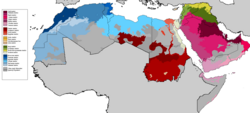Morocco
From Wikipedia, the free encyclopedia
For other uses, see Morocco (disambiguation).
| Kingdom of Morocco المملكة المغربية al-Mamlaka al-Maġribiyyah | ||||||
|---|---|---|---|---|---|---|
| ||||||
| Motto: الله، الوطن، الملك Allāh, al Waṭan, al Malik God - Homeland - King | ||||||
| Anthem: "Hymne Chérifien" | ||||||
| The striped area on the map shows Western Sahara, most of which is de facto administered by Morocco as its "Southern Provinces". Its sovereignty is currently in dispute. | ||||||
| Capital | Rabat 34°02′N 6°51′W | |||||
| Largest city | Casablanca | |||||
| Official language(s) | Arabic[1][2] | |||||
| Recognised national languages | Moroccan Arabic, Berber, French, Spanish | |||||
| Ethnic groups | Arab-Berbers 99.1%, Jews 0.2%, others 0.7%[3] | |||||
| Demonym | Moroccan | |||||
| Government | Constitutional monarchy | |||||
| - | King | Mohammed VI | ||||
| - | Prime Minister | Abbas El Fassi | ||||
| Unification | 780 | |||||
| - | Unified by Idrisid dynasty | 780–974 | ||||
| - | Alaouite dynasty | 1666–current | ||||
| - | Independence from France | March 2, 1956 | ||||
| - | Independence from Spain | April 7, 1956 | ||||
| Area | ||||||
| - | Total | 710,850 km2 (57th) 274,460 sq mi | ||||
| - | Water (%) | 250 km² (0,056%) | ||||
| Population | ||||||
| - | 2009 estimate | 32,200,000[4] (38th) | ||||
| - | 2004 census | 29,680,069[4] | ||||
| - | Density | 71.6/km2 (122nd) 185.5/sq mi | ||||
| GDP (PPP) | 2010 estimate | |||||
| - | Total | $151.432 billion[5] | ||||
| - | Per capita | $4,754[5] | ||||
| GDP (nominal) | 2010 estimate | |||||
| - | Total | $103.482 billion[5] | ||||
| - | Per capita | $3,249[5] | ||||
| HDI (2010) | ||||||
| Currency | Moroccan dirham (MAD) | |||||
| Time zone | WET (UTC+0) | |||||
| - | Summer (DST) | WEST (UTC+1) | ||||
| Drives on the | right | |||||
| ISO 3166 code | MA | |||||
| Internet TLD | .ma | |||||
| Calling code | +212 | |||||
| *All data excludes the Western Sahara, much of which is under Moroccan de facto administrative control. | ||||||
| 1 | French is neither official nor national, but it is widely used in official government documents, and by the business community. Moroccan Arabic or Darija is a common native language, and it is spoken but not written, like other Arabic dialects. Classical Arabic is the official language, and it is used for education, reading, writing and administration and is broadcast on television in news only. Amazigh languages are unofficially considered as national languages but are rather regional dialects spoken besides Moroccan Arabic throughout the country. | |||||
Morocco is a constitutional monarchy with an elected parliament. The King of Morocco holds vast executive powers, including dissolving parliament at will. Executive power is exercised by the government but more importantly by the king himself. Legislative power is vested in both the government and the two chambers of parliament, the Assembly of Representatives and the Assembly of Councillors. The king can also issue decrees called dahirs which have the force of law. Parliamentary elections were held in Morocco on 7 September 2007, and were considered by some neutral observers to be mostly free and fair; although voter turnout was estimated to be 37%, the lowest in decades. The political capital is Rabat, and the largest city is Casablanca; other large cities include Marrakesh, Tetouan, Tangier, Salé, Fes, Agadir, Meknes and Oujda.
The population speak a mixture of Darija and Berber languages of Morocco with many regional dialects. Berber-speaking Moroccans can be divided in three main dialectal groups: Riffians, Shlouh Berbers and Middle-Atlas Berbers.







